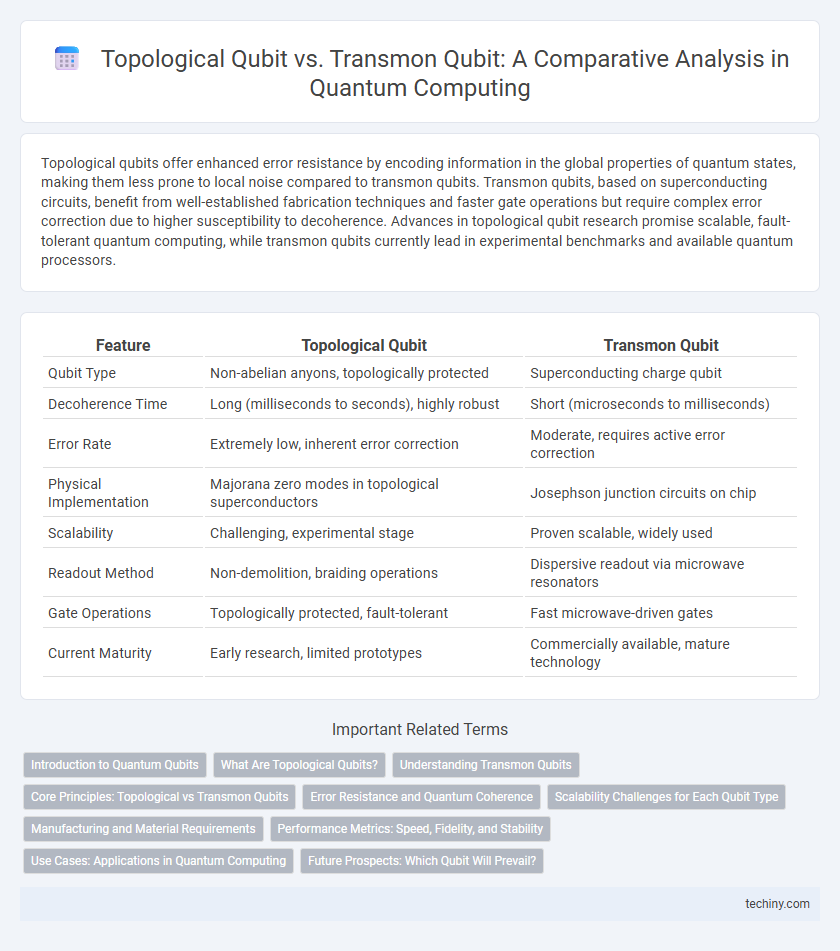Topological qubits offer enhanced error resistance by encoding information in the global properties of quantum states, making them less prone to local noise compared to transmon qubits. Transmon qubits, based on superconducting circuits, benefit from well-established fabrication techniques and faster gate operations but require complex error correction due to higher susceptibility to decoherence. Advances in topological qubit research promise scalable, fault-tolerant quantum computing, while transmon qubits currently lead in experimental benchmarks and available quantum processors.
Table of Comparison
| Feature | Topological Qubit | Transmon Qubit |
|---|---|---|
| Qubit Type | Non-abelian anyons, topologically protected | Superconducting charge qubit |
| Decoherence Time | Long (milliseconds to seconds), highly robust | Short (microseconds to milliseconds) |
| Error Rate | Extremely low, inherent error correction | Moderate, requires active error correction |
| Physical Implementation | Majorana zero modes in topological superconductors | Josephson junction circuits on chip |
| Scalability | Challenging, experimental stage | Proven scalable, widely used |
| Readout Method | Non-demolition, braiding operations | Dispersive readout via microwave resonators |
| Gate Operations | Topologically protected, fault-tolerant | Fast microwave-driven gates |
| Current Maturity | Early research, limited prototypes | Commercially available, mature technology |
Introduction to Quantum Qubits
Quantum qubits serve as the fundamental units of quantum information, enabling superposition and entanglement essential for quantum computing. Topological qubits leverage non-abelian anyons and braiding statistics to offer inherent error resistance through topological protection. Transmon qubits utilize superconducting circuits with reduced charge noise sensitivity, providing a scalable and experimentally accessible platform for current quantum processors.
What Are Topological Qubits?
Topological qubits are quantum bits that leverage the principles of topology to encode information in a way that is naturally protected from local noise and decoherence. Unlike transmon qubits, which rely on superconducting circuits prone to environmental disturbances, topological qubits utilize anyons and non-Abelian statistics to create fault-tolerant quantum states. This inherent error resilience offers significant advantages for scalable and stable quantum computing architectures.
Understanding Transmon Qubits
Transmon qubits, a prevalent type of superconducting qubit, leverage Josephson junctions to encode quantum information with reduced charge noise sensitivity, enhancing coherence times. They operate by balancing anharmonicity and charging energy to suppress decoherence, making them highly suitable for scalable quantum processors. Compared to topological qubits, transmons are more experimentally advanced but face challenges in error rates and qubit connectivity.
Core Principles: Topological vs Transmon Qubits
Topological qubits leverage the principles of topological quantum states, encoding information in non-Abelian anyons that provide intrinsic protection against local noise and decoherence. Transmon qubits operate based on superconducting circuits with Josephson junctions, where qubit states are defined by charge-phase balance but remain susceptible to charge noise and require error correction. The core distinction lies in the topological qubit's inherent error resilience through global quantum state properties, whereas transmon qubits rely on circuit design and external controls for coherence maintenance.
Error Resistance and Quantum Coherence
Topological qubits leverage non-abelian anyons to encode quantum information, offering superior error resistance by inherently protecting against local decoherence and environmental noise. Transmon qubits, based on superconducting circuits, exhibit shorter coherence times due to susceptibility to charge noise and dielectric loss despite advancements in fabrication techniques. The intrinsic fault-tolerance of topological qubits promises more stable quantum coherence essential for scalable quantum computing architectures.
Scalability Challenges for Each Qubit Type
Topological qubits offer inherent error protection due to their non-abelian anyons, potentially enabling higher scalability by reducing quantum error correction overhead; however, their physical realization remains experimentally challenging with limited material platforms. Transmon qubits benefit from well-developed superconducting circuit technology and relatively straightforward fabrication, yet scalability is hindered by crosstalk, coherence time limitations, and the exponential growth of control lines required for large quantum processors. Overcoming these scalability challenges in both qubit types is critical for advancing fault-tolerant quantum computing architectures.
Manufacturing and Material Requirements
Topological qubits require exotic materials such as topological insulators or semiconductors with strong spin-orbit coupling, demanding highly controlled fabrication environments to maintain coherence and implement non-Abelian anyons. Transmon qubits are typically fabricated using aluminum or niobium superconducting circuits on silicon or sapphire substrates, leveraging well-established semiconductor manufacturing techniques for scalability. The complex heterostructures and precise nanofabrication needed for topological qubits pose greater material and manufacturing challenges compared to the more mature and standardized processes for transmon qubits.
Performance Metrics: Speed, Fidelity, and Stability
Topological qubits offer superior stability and inherently error-resistant properties due to their non-Abelian anyons, which significantly reduce decoherence compared to transmon qubits. Transmon qubits provide faster gate speeds and higher fidelity in current superconducting quantum processors but are more susceptible to noise and require complex error correction. The trade-off between topological qubits' robust coherence times and transmon qubits' operational speed and fidelity remains a critical focus in advancing scalable quantum computing architectures.
Use Cases: Applications in Quantum Computing
Topological qubits offer enhanced fault tolerance and stability, making them ideal for large-scale, error-resistant quantum computing tasks such as complex cryptographic algorithms and quantum simulations. Transmon qubits, with faster gate speeds and easier integration into current superconducting quantum processors, are preferred for near-term quantum algorithms and quantum machine learning applications. The choice between topological and transmon qubits depends on the requirement for error correction and operational coherence in specific quantum computing use cases.
Future Prospects: Which Qubit Will Prevail?
Topological qubits promise inherent error resilience due to their non-abelian anyon states, potentially enabling more stable and scalable quantum computing architectures compared to transmon qubits, which rely on superconducting circuits but face coherence time limitations. Advances in material science and quantum error correction position topological qubits as a strong candidate for future fault-tolerant quantum computers, while transmon qubits currently dominate near-term quantum hardware implementations due to their relative maturity and ease of fabrication. The future of quantum computing may see a hybrid approach leveraging the robustness of topological qubits with the practical engineering advantages of transmon qubits to achieve scalable and reliable quantum systems.
Topological Qubit vs Transmon Qubit Infographic

 techiny.com
techiny.com